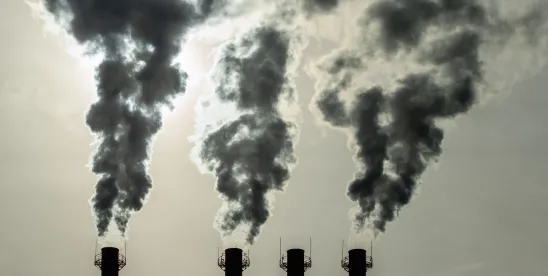On 19 January 2021, the eve of inauguration for the Biden Administration, the United States Court of Appeals for the District of Columbia Circuit (D.C. Circuit) struck down the Affordable Clean Energy Rule (ACE Rule).1 Issued under the Trump Administration’s Environmental Protection Agency (EPA), the ACE Rule repealed and replaced the formerly enacted Clean Power Plan (CPP)2 and sought to establish a more narrowly defined framework for the regulation of power plant greenhouse gas (GHG) emissions.3 As a premise for the ACE Rule, the Trump EPA argued that Section 111 of the Clean Air Act (CAA), codified at 42 U.S.C. § 7411, contains clear and unambiguous language limiting the EPA’s emission reduction measures to improvements “at” and “to” existing GHG emissions sources.4 However, the D.C. Circuit held that the CAA does not require the EPA to confine its GHG regulation in this way and, in fact, that the Trump EPA’s interpretation under the ACE Rule constituted a “fundamental misconstruction” of the statute.5 The D.C. Circuit also found that the ACE Rule’s extended compliance deadline requirements were arbitrary and capricious insofar as they relaxed the schedules for federal action and state compliance under Section 7411(d).6 The D.C. Circuit’s decision clears the way for the Biden EPA to establish a new regulatory framework for power plant GHG emissions.
The EPA’s regulation of power plant GHG emissions is traceable to the U.S. Supreme Court’s decision in Massachusetts v. EPA, 549 U.S. 497 (2007). In that decision, the Supreme Court held that carbon dioxide and other greenhouse gas emissions constituted “air pollutant[s]” for purposes of motor vehicle regulation under Title II of the CAA.7 The Court directed the EPA to establish standards for GHG emissions from vehicles unless the EPA determined that GHGs did not contribute to climate change.8 The EPA found that such GHGs are polluting the atmosphere and endangering human health.9 This “endangerment finding,” as a corollary, was viewed as triggering an obligation in EPA to adopt performance standards for new stationary sources of GHG emissions and states to adopt plans that establish performance standards for existing stationary sources of those emissions. The reason is that Section 7411 of the statute directs the EPA and states to regulate in this way if the stationary sources “cause[], or contribute[] significantly to, air pollution” that “may reasonably be anticipated to endanger public health or welfare.”10 Accordingly, the CPP, adopted in 2015, and the more recent ACE Rule embodies the EPA’s most recent efforts to conform power plants’ emission levels to the strictures of the CAA.
Using the CPP, the EPA sought to reduce GHG emissions through three methods.11 The first method focused on on-site technology improvements for power plants.12 The second and third methods focused on “generation shifting,” achieved by prioritizing lower-emission energy sources over higher-emission sources of energy.13 Specifically, the second method added the “substitut[ion of] increased generation from lower-emitting existing natural gas” for generation from primarily coal-fired, higher-emitting power plants.14 Similarly, the third method prioritized the use of zero-emitting renewable energy sources over high-emitting power plants.15 Together, the CPP deemed these three methods the “best method of emission reduction.”16 However, before taking effect, the CPP was challenged in court, with the challenge ultimately being dismissed as the EPA reassessed its position.17
In 2019, the EPA issued the ACE Rule, thereby repealing and replacing the CPP.18 The EPA explained that it interpreted Section 7411(d) of the CAA to unambiguously constrain emissions reduction methods to those measures that can be put into place at a building, structure, facility, or installation.19 At its core, the ACE Rule disposed of the second and third “generation shifting” methods utilized under the CPP and confined permissible emission reduction measures to physical changes to the power plants themselves.20 The ACE Rule also relaxed the timeline requirements for states to develop and submit their emissions reduction plans for existing stationary sources and the EPA to act on states’ plans.21
The D.C. Circuit’s 19 January 2021 decision rejected the EPA’s interpretation of Section 7411(a)(1) (which defines “standard of performance,” among other terms) as requiring the EPA to confine emissions reductions measures to those applicable “at and to the source.”22 The court explained that the EPA incorrectly applied source-specific language found in Section 7411(d)(1) to its reading of subsection (a)(1).23 The court noted that the plain language of subsection (a)(1) does not support the interpretation embodied in the ACE Rule, nor does a reading of subsections (a)(1) and (d)(1) taken together.24 Looking at the definition of “standard of performance” in subsection (a)(1), the court stated that “Congress imposed no limits on the types of measures the EPA may consider beyond three additional criteria: cost, any nonair quality health, and environmental impacts, and energy requirements.”25 Lastly, the court found that the ACE Rule’s extension of compliance deadlines failed for lack of reasoned support.26 Specifically, the court held that the EPA modeled the compliance deadlines after those found in the National Ambient Air Quality Standards (NAAQS) without addressing the differences between the NAAQS and performance standards for stationary sources.27 Moreover, the court stated that the EPA disregarded environmental and public health considerations in adopting extended compliance deadlines.28
The court did not state whether the EPA’s interpretation of the CAA was impermissible. Rather, the court noted that “deference to an agency’s interpretation of a statute is not appropriate when the agency wrongly believes that interpretation is compelled by Congress.”29 Because the EPA contended that its interpretation was the only permissible interpretation of the scope of its authority, the court could not defer to that reading even if it was one of several permissible interpretations of the statutory language.30 The court vacated the ACE Rule and remanded it to the EPA for further consideration in light of the ambiguity that the court found in the language of Section 7411(a)(1).31 While the D.C. Circuit did not uphold the ACE Rule, it did not reinstate the 2015 CPP. Notably, by vacating the ACE Rule, the court provided the Biden Administration with a path to construct a new framework for regulating greenhouse gas emissions from power plants. EPA is likely to commence this significant task within the first hundred days of the Biden administration and against the backdrop of President Biden’s 20 January 2021 acceptance of the 12 December 2015 Paris Climate Agreement.32 EPA’s new rule will almost certainly require owners and operators of power plants that generate GHGs to be more strategic and efficient in how they operate their plants -- both collectively and individually -- going forward.
1Am. Lung Ass'n v. EPA, 2021 U.S. App. LEXIS 1333 (D.C. Cir. Jan. 19, 2021).
2Id. at 32.
3Id. at 32–33.
4Id.
5Id. at 16, 146.
6Id.
7See 549 U.S. 497, 528 (2007). On the other hand, in Utility Air Regulatory Group v. EPA, 573 U.S. 302 (2014), the Supreme Court concluded that GHGs are not “air pollutant[s]” for purposes of the permitting triggers under the CAA stationary source permit programs, which apply to power plants.
8549 U.S. at 533.
92009 Endangerment Finding, 74 Fed. Reg. at 66,497.
1042 U.S.C. § 7411(b)(1)(A); see id. § 7411(d), (f) (providing that the EPA Administrator “shall” adopt performance standards for existing and new sources of air pollution).
1180 Fed. Reg. at 64,667.
1280 Fed. Reg. at 64,667.
1380 Fed. Reg. at 64,667.
1480 Fed. Reg. at 64,667.
1580 Fed. Reg. at 64,667.
1642 U.S.C. § 7411(a)(1).
17West Virginia v. EPA, No. 15-1363, Docs. 1673071, 1806952.
18See Repeal of the Clean Power Plan; Emission Guidelines for Greenhouse Gas Emissions from Existing Electric Utility Generating Units; Revisions to Emission Guidelines Implementing Regulations, 84 Fed. Reg. 35,500 (July 8, 2019).
19ACE Rule. 84 Fed. Reg. at 32,523–32,524.
20ACE Rule. 84 Fed. Reg. at 32,525, 32,537.
21See 40 C.F.R. § 60.23a(a)(1); see also 40 C.F.R. §§ 60.27a(b)–(c).
22Am. Lung Ass'n v. EPA, 2021 U.S. App. LEXIS 1333 at 48 (D.C. Cir. Jan. 19, 2021).
23Id.
24Id.
25Id. at 50; 42 U.S.C. § 7411(a)(1).
26Am. Lung Ass'n v. EPA, 2021 U.S. App. LEXIS 1333 at 139 (D.C. Cir. Jan. 19, 2021).
27Id. at 142.
28Id. at 143.
29Id. at 50 (quoting Peter Pan Bus Lines, Inc. v. Fed. Motor Carrier Safety Admin., 471 F.3d 1350, 1354 (D.C. Cir. 2004).
30See Negusie v. Holder, 555 U.S. 511, 521 (2009).
31Am. Lung Ass'n v. EPA, 2021 U.S. App. LEXIS 1333 at 147 (D.C. Cir. Jan. 19, 2021).
32See THE WHITE HOUSE, EXEC. OFFICE OF THE PRESIDENT, STATEMENTS AND RELEASES, https://www.whitehouse.gov/briefing-room/statements-releases/2021/01/20/paris-climate-agreement/ (last visited Jan. 21, 2020).





 />i
/>i
